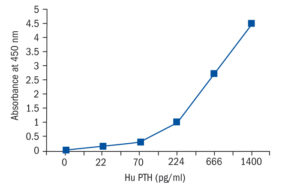Parathyroid Hormone (PTH) Human ELISA
Human parathyroid hormone (hPTH) is a major physiological regulator of phosphocalcic metabolism. hPTH increases serum calcium concentrations by its actions on kidney (enhancing tubular Ca++ reabsorption and phosphate excretion) and bone (stimulating osteoclastic activity and bone resorption). It indirectly affects intestinal absorption of Ca++ by stimulating renal 1α-hydroxylation of 25 hydroxyvitamin D. The release of PTH is controlled in a negative feedback loop by the serum concentration of Ca++. PTH is synthesized in the chief cells of the parathyroid glands and secreted as an 84 amino acid molecule called “intact PTH”, which is the main bioactive product. This molecule is degraded by proteolytic cleavage between amino acids 33–37 at peripheral sites to form biologically active aminoterminal fragments and biologically inactive carboxyl-terminal fragments. The carboxyl-terminal fragments are cleared only by glomerular filtration, while the bioactive intact PTH and amino-terminal fragments are also metabolically degraded in the liver and other tissues. The half-life of the carboxylterminal fragments increases dramatically in patients with renal failure. Thus, the measurement of intact PTH correlates best with the hormone production and biological activity. The measurement of intact hPTH is used to establish the diagnosis of primary hyperparathyroidism by demonstrating elevated serum levels of bioactive PTH. It allows documenting the occurrence of secondary hyperparathyroidism in patients with Vit.D deficiency, intestinal malabsorption, or renal failure. In this last situation, the absence of interference with the inactive carboxyl-terminal fragments is especially valuable. The specificity and high sensitivity of the assay also allows differentiating clearly low serum PTH levels in hypoparathyroidism or in tumor-induced hypercalcaemia.
Research topic
Bone and cartilage metabolism, Oncology
Type
Sandwich ELISA, HRP-labelled antibody
Applications
Serum, Plasma
Sample Requirements
200 µl/well
Storage/Expiration
Store the complete kit at 2–8°C. Under these conditions, the kit is stable until the expiration date (see label on the box).
Calibration Curve

Calibration Range
15–1040 pg/ml
Limit of Detection
2 pg/ml
– Chang WT, Wu CH, Hsu LW, Chen PW, Yu JR, Chang CS, Tsai WC, Liu PY. Serum vitamin D, intact parathyroid hormone, and Fetuin A concentrations were associated with geriatric sarcopenia and cardiac hypertrophy. Sci Rep. 2017 Jan 23;7:40996. doi: 10.1038/srep40996

